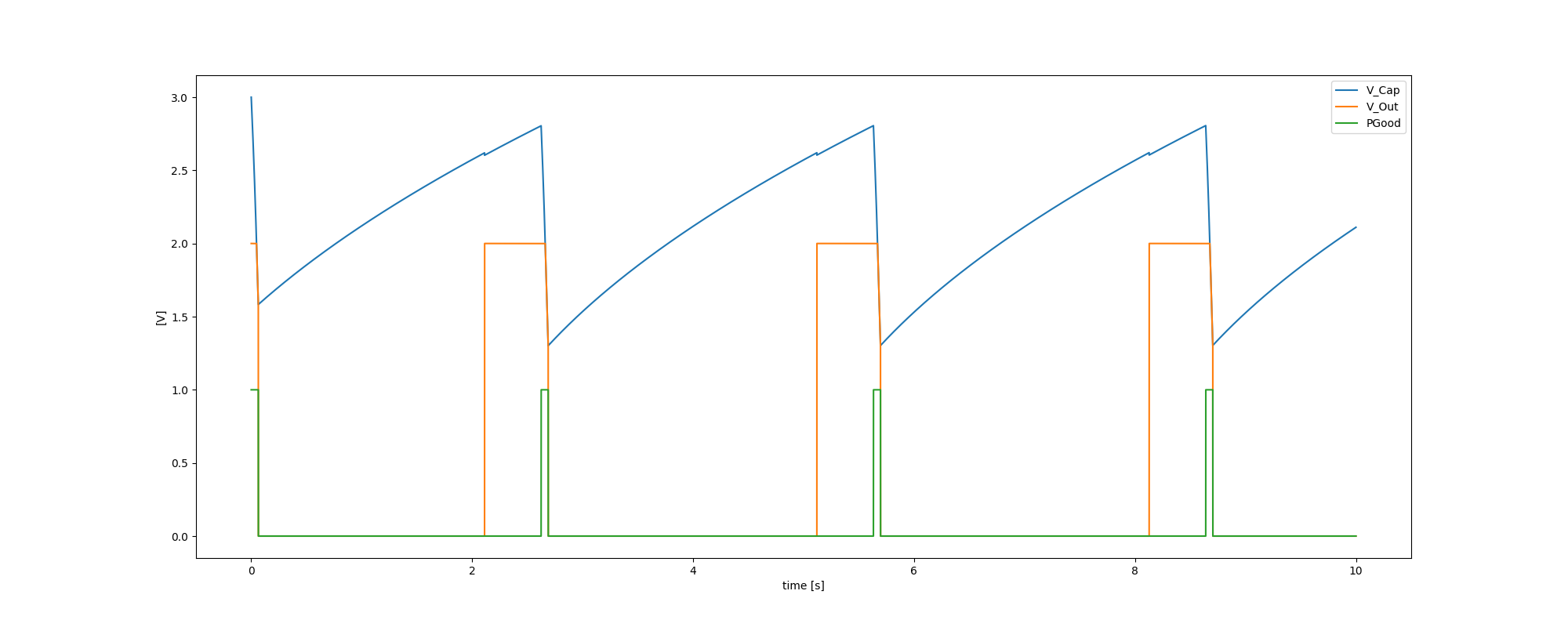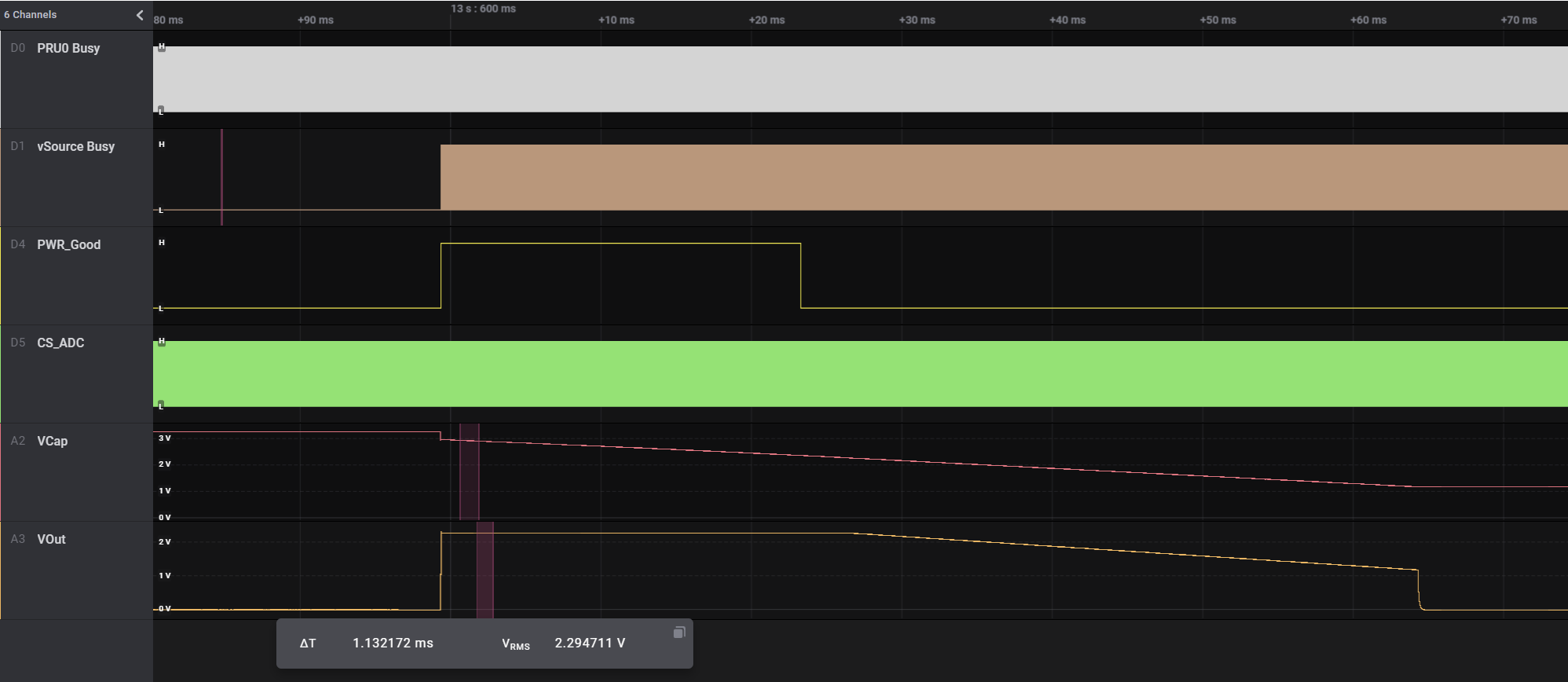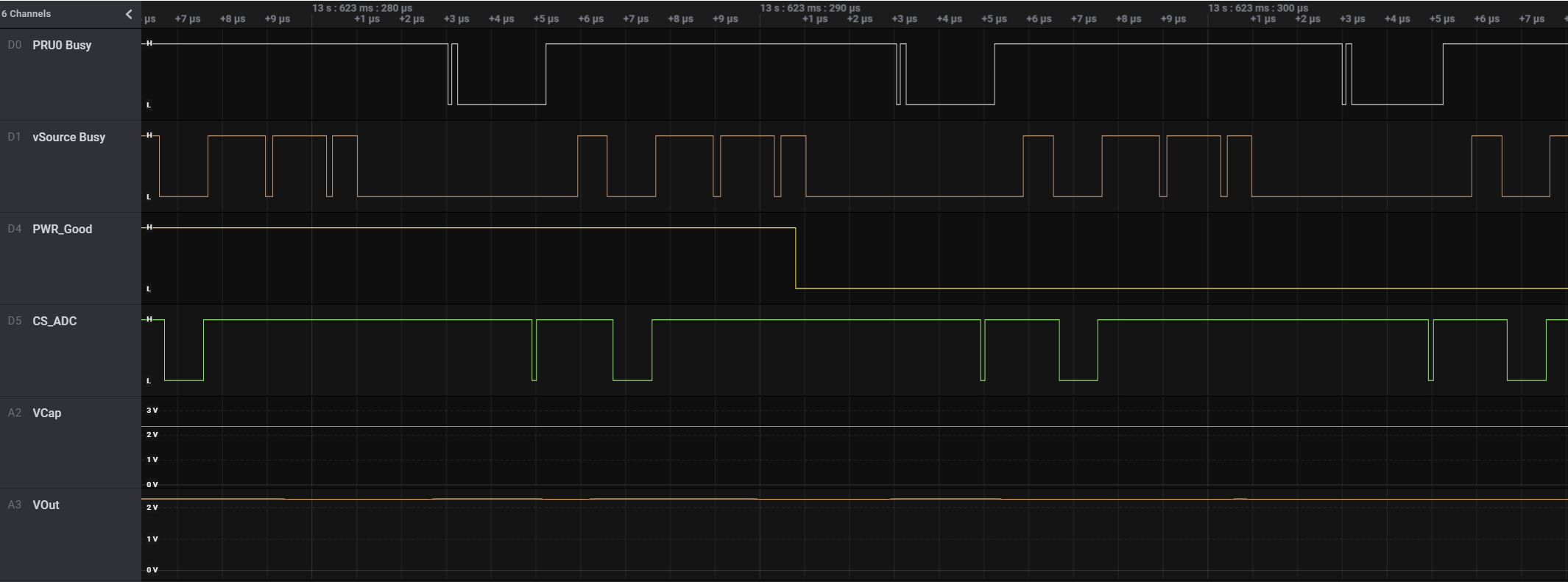Virtual Source
Current Features
general features
fully customizable per yaml-parameter-set
or choose one of the predefined sets by name ie. “virtsource: BQ25504s” for the BQ-Regulator with pwr-good-schmitt-trigger
inherit from existing parameter-sets with ie. “converter-base: neutral” (neutral is default inheritance) ⇾ only altered parameters needed in new set
emulator can either record output or intermediate node (storage cap)
Input
oneway, imagine a perfect diode at the start so no current can flow back
diode voltage-drop can be configured from 0 to x Volt
maxima for input voltage and current (power limit)
Boost-converter, optional, with
enable minimum threshold voltage for input
disable maximum threshold for boost-output (intermediate voltage)
efficiency factor with 2D-LUT (12x12), depending on input voltage & current
thresholds are configurable in 2^n steps
voltage divisions are linear, depending on lowest threshold
current-divisions are log2, also depending on lowest threshold
example: voltage threshold n=7 is setting first array boundary to 2^7 = 128 uV, so lut[0] is for V < 128 uV, lut[1] is for 128 to 256 uV
capacitor, optional, with
capacitance from 1 nF to 1 F
initial voltage
leakage current
switchable output, hysteresis with checks at defined intervals
power-good-signal with hysteresis either in intervals or immediate (schmitt-trigger)
buck converter, optional, with
fixed output voltage
ldo-drop-voltage, alternatively working like a diode when buck is off or intermediate voltage is below output-voltage + drop-voltage
efficiency factor with 1D-LUT, depending on output-current
threshold is configurable in 2^n-steps
current-divisions are log2, depending on lowest threshold
example: current threshold n=5 is setting first array boundary to 2^5 = 32 nA, so lut[0] is for I < 32 nA, lut[1] is for [32, 64] nA, lut[2] is for [64, 128] nA
switchable output
simulated external Capacitor - should be set to buffer size of target: fast transients can’t be fully monitored by shepherd


Implementation
fixed point math with u32 & u64 with voltages in uV, currents in nA, power in fW, capacity in nF
a python port is available
modules
InputPower - calculated from recorded C-V-traces
OutputPower - voltage is set by DAC, current is measured by ADC
CapacitorUpdate - Voltage delta is calculated by resulting sum of Power
regulatorUpdate - handles internal States and Output
limits
input power can be 56 bit in size (fW = uV * nA) ⇾ ~ 72 W
lowest value for algorithm is 64 fW, but due to ADC limitations 195 nA * 19 uV = 3.7 pW
output power can be 50 bit in size (fW = uV * nA) ⇾ ~ 1 W
difference to input due to inverted efficiency taking 14 instead of 8 bit
capacitor voltage can be 4.2 kV
due to custom faster division-function the range with low error is 0 to 5 V
optimization in calc_out_power limits voltage to 2^28 uV = 268 V, lower bound is 64 uV
storage capacitor can not be larger than 2.68 F (= 10*(2^28) nF), reasonable boundaries are [1 nF, 100 mF]
Speed in PRU (max timings)
280 ns calc input power
3200 ns calc output power
10500 ns update capacitor
470 ns update boost-buck
~14000 ns for all (with space in between)
Optimizing Algorithm for Speed
a custom uDiv() brings “update cap” down to 7500 ns, whole iteration takes 11684 ns
leaving out I_leakage is significantly faster (calc output is done in 310 ns instead of 3200, similar to input) but resulting output-power is wrong
seems to be undefined behavior introduced by implicit typecasting
⇾ undefined it is! see documentation below
new ruleset:
u64 add, sub, shift are fine and fast!
u64 mul should be avoided, duration is depending on size of number (3000 - 4800 - 6400 ns for 4, 16, 32 bit)
u32 * u32 can give u64 result when both or last factor are typecasted - it is still fast! ⇾ uint64_t result = (uint64_t)num32a * (uint64_t)num32b;
using the ruleset brings:
280 ns calc input power
430 ns calc output power
5400 ns update capacitor
540 ns update boost-buck
resulting time is around 6900 - 7060 ns
using a custom mul64()-function
280 ns calc input power
500 ns calc output power
950 ns update capacitor
540 ns update boost-buck
resulting in < 2600 ns for all
adding boundary checks for math-ops
700 ns calc input power
1350 ns calc output power
1300 ns update capacitor
580 ns update boost-buck
resulting in < 4300 ns for all
TODO: benchmark new extended code
How PRU0 Spends the 10 us per Cycle
~ 1 - 2 us busy waiting for trigger (headroom for more workload)
100 ns trigger ADC-Reading
200 ns getting to Sampling Routine
650 ns load remote buffer-values (input IV)
700 ns calculate input power
1100 ns read ADC, output current
1300 ns calculate output power
1300 ns update capacitor
580 ns update boost-buck
2000 ns write DAC (currently both channels are written for debug) and buffer-output
200 ns message handling


Performance on real hardware
dataset: indoor_solar/sheep4/office_sd.h5
cap 22 uF, 50% eta_in, 80% eta_out
sim-sets
10 mA drain shows dutycycle of ~ 0.27 %, On-Time is ~ 800us
1 mA drain, dutycycle ~ 2.7 %, On-Time ~ 8.16 ms.
cap voltage moves between power-good-thresholds of 2.4 and 2.8 V




Dev Scratch Area
TI Compiler behavior
// u64 * u64 ⇾ 7 us
// u32 * u64 ⇾ 2.56 us
// u64 * u32 ⇾ 0.03 us, es rechnet nur u32*u32
uint64_t debug_math_fns(const uint32_t factor, const uint32_t mode)
{
const uint64_t f2 = factor + ((uint64_t)(factor) << 32);
const uint64_t f3 = factor - 10;
GPIO_TOGGLE(DEBUG_PIN1_MASK);
uint64_t result = 0;
if (mode == 1)
{
const uint32_t r32 = factor * factor;
result = r32;
} // ~ 28 ns, limits 0..65535
else if (mode == 2) result = factor * factor; // ~ 34 ns, limits 0..65535
else if (mode == 3) result = (uint64_t)factor * factor; // ~ 42 ns, limits 0..65535 ⇾ wrong behavior!!!
else if (mode == 4) result = factor * (uint64_t)factor; // ~ 48 ns, limits 0..(2^32-1) ⇾ works fine?
else if (mode == 5) result = (uint64_t)factor * (uint64_t)factor; // ~ 54 ns, limits 0..(2^32-1)
else if (mode == 5) result = ((uint64_t)factor)*((uint64_t)factor); // ~ 54 ns, limits 0..(2^32-1)
else if (mode == 11) result = factor * f2; // ~ 3000 - 4800 - 6400 ns, limits 0..(2^32-1) ⇾ time depends on size (4, 16, 32 bit)
else if (mode == 12) result = f2 * factor; // same as above
else if (mode == 13) result = f2*f2; // same as above
else if (mode == 21) result = factor + f2; // ~ 84 ns, limits 0..(2^31-1) or (2^63-1)
else if (mode == 22) result = f2 + factor; // ~ 90 ns, limits 0..(2^31-1) or (2^63-1)
else if (mode == 23) result = f2 + f3; // ~ 92 ns, limits 0..(2^31-1) or (2^63-1)
else if (mode == 24) result = f2 + 1111ull; // ~ 102 ns, overflow at 2^32
else if (mode == 25) result = 1111ull + f2; // ~ 110 ns, overflow at 2^32
else if (mode == 26) result = f2 + (uint64_t)1111u; //
else if (mode == 31) result = factor - f3; // ~ 100 ns, limits 0..(2^32-1)
else if (mode == 32) result = f2 - factor; // ~ 104 ns, limits 0..(2^64-1)
else if (mode == 33) result = f2 - f3; // same
else if (mode == 41) result = ((uint64_t)(factor) << 32u); // ~ 128 ns, limit (2^32-1)
else if (mode == 42) result = (f2 >> 32u); // ~ 128 ns, also works
GPIO_TOGGLE(DEBUG_PIN1_MASK);
return result;
}
BQ25504 - Datasheet RevE
Input MAX: 0.1 A, 3 V, 300 mW
Input MIN: Cold Start Voltage 0.6 V, Harvesting down to 130 mV, Datasheet speaks of 10uW min Charging
Quiescent Current Iq_vstor < 330 nA for UV Condition, 570 nA in OV
Battery Charge Voltage 2.5 - 5.25 V
VBAT_OK-Signal
Caps
Input 4.23 - 5.17 uF
Storage 4.23 - 5.17 uF
Battery 100 uF and more
VBatOV 2.5 - 5.25 V
VBatUV 2.2 - VBatOV
Input Efficiency (Page 9)
10 uA: 0 % for 130 mV, 90 % for 3 V
100 uA: 10 % for 130 mV, 90 % for 3 V
10 mA: 40 % for 130 mV, 93 % for 3 V
model needs better definition of limits
TODO: continue on p. 11, https://www.ti.com/lit/ds/symlink/bq25504.pdf?ts=1625558784652&ref_url=https%253A%252F%252Fwww.ti.com%252Fproduct%252FBQ25504%253Futm_source%253Dgoogle%2526utm_medium%253Dcpc%2526utm_campaign%253Dapp-null-null-GPN_EN-cpc-pf-google-eu%2526utm_content%253DBQ25504%2526ds_k%253DBQ25504%2526DCM%253Dyes%2526gclid%253DEAIaIQobChMI_6nZmf7N8QIVmrd3Ch3Q4AxNEAAYASAAEgKpwPD_BwE%2526gclsrc%253Daw.ds
Implemented
pru - check overflow with custom mul(), add(), sub() and limit to max / min
add min to limits in python
change efficiency to native 0 - 1 num
extend converter: pre-power: voltage, duration
extend converter: i-inp-max, v-inp-max,
check and warn about limits in Python
add BQ25504
HowTo fill Efficiency LUTs:
find lowest threshold for current and voltage
it helps to add current/voltage-values for each column/row as comment on the outside
additional help: use editor that can highlight a string and fill table with placeholders (1.00 or 0.00 should work)
efficiency-graphs in datasheet allowed to deduct values and fill single columns and rows of 12x12-Table
the bq25504-input LUT had less than 30 (of 144) undetermined values ⇾ interpolation with not much guesswork
BQ25570
implemented / defined and tested